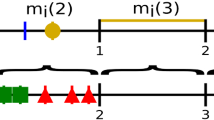Abstract
I develop an approach for estimating the determinants of stock price changes that uses all eligible trade data and other observable parameters of market activity. This approach backs out the unobserved continuous price change distribution from the observable discrete price changes, and does not constrain the determinants to be proportions of the traded bid-ask spread. I show that theoretically impermissible results and skewed estimates of cost components are obtained when the model used for estimating the determinants of stock price changes does not attempt to uncover the mapping between the observed price changes and the underlying unobserved continuous price change process, and does not effectively use all eligible trade data.
Similar content being viewed by others
References
Cho, D., and E. Frees. 1988. “Estimating the Volatility of Discrete Stock Prices.”Journal of Finance 43: 451–466.
Clarke, J. and K. Shastri. 2000. “On Information Asymmetry Metrics.” Working Paper. University of Pittsburgh.
Dennis, P., and J. Weston. 2001. “Who’s Informed? An Analysis of Stock Ownership and Informed Trading.” Working Paper University of Virginia and Rice University.
Easley, D., and M. O’Hara. 1992. “Time and the Process of Security Price Adjustment.”Journal of Finance 47: 577–605.
George, T., G. Kaul, and M. Nimalendran. 1991. “Estimation of the Bid Ask Spreads and Its Components: A New Approach.”Review of Financial Studies 4: 623–656.
Glosten, L.R., and L. Harris. 1988. “Estimating the Components of the Bid-Ask Spreads.”Journal of Financial Economics 21: 123–142.
Hasbrouck, J. 2003. “Trading Costs and Returns for US Equities: The Evidence from Daily Data.” Working Paper New York University.
Hasbrouck, J., and G. Sofianos. 1993. “The Trades of Market Makers: An Empirical Examination of NYSE Specialists.”Journal of Finance 48: 1565–1593.
Hausman, J., A. Lo, and C. MacKinlay. 1992. “An Ordered Probit Analysis of Transaction Stock Prices.”Journal of Financial Economics 31: 319–379.
Heflin, F., and K.W. Shaw. 2001. “Trade Size and the Adverse Selection Component of the Spread: Which Trades are “Big”?” Working Paper Purdue University and University of Maryland.
Holthausen, R., R. Leftwich, and D. Mayers. 1987. “The Effect of Large Block Transactions on Security Prices: A Cross-Sectional Analysis.”Journal of Financial Economics 19: 237–267.
Huang, R.D., and H. Stoll. 1997. “The Components of the Bid-Ask Spread: A General Approach.”Review of Financial Studies 10: 995–1034.
Knez, P.J., and M.J. Ready. 1996. “Estimating the Profits from Trading Strategies.”Review of Financial Studies 9: 1121–1164.
Krishnan, C.N.V., A. Singh, and A. Zebedee. 2006. “An Examination of Large Sell Orders in Cold IPO Aftermarkets.”Journal of Financial Markets 9: 119–143.
Lee, C.M.C., and M.J. Ready. 1991. “Inferring Trade Direction from Intraday Data.”Journal of Finance 46: 733–746.
Lin, J.C., G.C. Sanger, and C.G. Booth. 1995. “Trade Size and the Components of the Bid-Ask Spread.”Review of Financial Studies 8: 1153–1183.
Madhavan, A., M. Richardson, and M. Roomans. 1997. “Why do Security Prices Change? A Transaction-Level Analysis of NYSE Stocks.”Review of Financial Studies 10: 1035–1064.
Madhavan, A., and G. Sofianos. 1998. “An Empirical Analysis of NYSE Specialist Trading.”Journal of Financial Economics 48: 189–210.
Madhavan, A., and S. Smidt. 1993. “An Analysis of Changes in Specialist Inventories and Quotations.”Journal of Finance 48: 1595–1628.
Neal, R., and S.M. Wheatley. 1998. “Adverse Selection and Bid-Ask Spreads: Evidence from Closed-End Funds.”Journal of Financial Markets 1: 121–149.
Peng, L. 2001. “Dynamics of Effective Quotes and Spreads Between Consecutive Trades: A Real Time Structural Model of Price Formation.” Working paper. Yale University.
Stoll, H. 1989. “Inferring the Components of the Bid-Ask Spread: Theory and Empirical Tests.”Journal of Finance 44: 115–134.
Van Ness, B., R. Van Ness, and R. Warr. 2001. “How Well Do Adverse Selection Components Measure Adverse Selection?”Financial Management 30: 77–98.
Author information
Authors and Affiliations
Rights and permissions
About this article
Cite this article
Krishnan, C.N.V. Estimating the determinants of stock price changes. J Econ Finan 31, 234–249 (2007). https://doi.org/10.1007/BF02751645
Issue Date:
DOI: https://doi.org/10.1007/BF02751645




